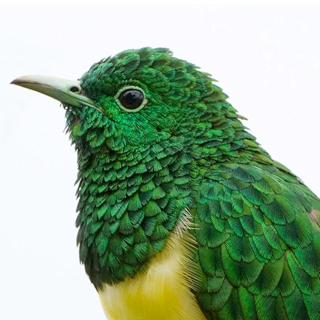Alumnus uncovers how cuckoo's feathers shimmer
By Krishna Ramanujan

Before Todd Harvey, Ph.D. ’12, was a graduate student at Cornell studying how light shimmers off feathers of the African emerald cuckoo and other birds, he spent 10 years as a computer animator and digital cinematographer implementing algorithms that made Gollum’s skin look real in “The Lord of the Rings” movies and gave King Kong’s fur its lifelike luster in the 2005 production.
In his industry job for Weta Digital, Harvey read science studies to understand how to simulate biological organisms on the screen. This self-education led him back to school, where he applied his computer skills to the field of zoology.
Now, a July 2013 study based on his doctoral thesis appears in Interface, a journal of the Royal Society, to explain why the colors in such iridescent birds as the African emerald cuckoo change from green to black depending on the viewer’s angle.
Shimmering plumages evolved in birds for communication and camouflage. Harvey and Kim Bostwick, curator of the Cornell Museum of Vertebrates, and Steve Marschner, Cornell associate professor of computer science, have found that branches of the cuckoo’s feather vanes have a microscopic zigzag structure that affects the direction of reflected light – and shift color – based on the viewer’s angle and the feather’s orientation to a light source.
The findings are relevant for bird behavioral studies to better understand avian signaling and courtship. Future work may lead to tools that field ornithologists would use to predict where a female might need to be to receive a signal from a flashy male bird, Harvey said. Also, material scientists may now examine the feather’s morphology to make new materials, and computer animators may develop new algorithms to make feathers more realistic on the big screen.
“As scientists we want to know why the world works the way it does,” said Harvey, a postdoctoral researcher in ecology and evolutionary biology at Yale University. “The appearance of things comes from structures that are smaller than the eyes can see,” he added.
Harvey and colleagues used Cornell’s microscale computed tomography scanner to obtain data of the African emerald cuckoo feather’s structure, which were then reconstructed into 3-D images. They also measured reflectance from hundreds of directions to quantify how a feather appears from any viewing or illumination angle, Harvey said.
The 3-D data revealed that the feather’s herringbone zigzag structure has branching hairlike filaments, called barbules, that are raised from the plane of the feather. Also, the cross sections of the barbules are curved. The combined morphology produces two cones of reflected light, each centered on a barbule branch, which is tilted by the angle of the zigzag. A green reflection appears when the viewer’s eyes are in line with the light cones, but if the cones are not within the viewer’s perspective, then the appearance is black. This explains the shimmering, due to changes in the orientation of the light cones, which are dependent on feather structure, angle of the light source and location of the viewer.
“I believe that as we extend our research to additional species, we will find similar correlations between morphology of the iridescent barbule and the direction of its reflectance,” said Harvey.
The research was supported by the National Science Foundation.
Media Contact
Get Cornell news delivered right to your inbox.
Subscribe